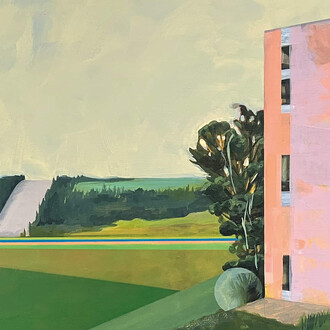A focused exhibition of work by celebrated conceptual artist Charles Gaines opens in St. Moritz, marking the first presentation in Europe dedicated to Gaines’s drawing practice from the historic Numbers and Trees series.
The exhibition displays two distinct bodies of work executed over the last five years. The first floor presents meticulously rendered ink drawings from the celebrated Central Park series, which can be seen as precursors (or ‘templates’) for Gaines’s renowned larger scale, Plexiglas works. Employing a rule-based numeric system to create soft, numbered marks on a hand-drawn grid, each drawing isolates the individual trees that eventually comprise the completed series. The second floor honours 24 vibrant new watercolors of assorted trees. The exhibition allows for an unprecedented insight into his practice and an intimate look into his systems and processes.
A pivotal figure in the field of conceptual art, Gaines has long employed a generative process to create series of works in a variety of mediums. By creating space between a specific symbol and the systems applied to its representation through measurable values of color, Gaines’s distinctive approach forges a critical link between first generation American conceptualists like Sol LeWitt and subsequent generations of artists, including Gaines’s students Edgar Arcenaux, Andrea Bowers, Mark Bradford, and Sam Durant, among others who are pushing the limits of conceptualism today. Speaking about his longstanding commitment to unveiling the paradoxes of human visual understanding, Gaines said, ‘The system has never changed, but the outcome is always different.’
Images of trees have recurred time and again in Gaines’s practice since the mid-1970s when he first began charting their varying forms through a system of numbered grids in the series Walnut Tree Orchard (1975 – 2014). His methodical examination continues in the Numbers and Trees series, which began in 1987. In his large-scale Plexiglas works, Gaines selectively layers paint on acrylic sheets atop black and white photographs of corresponding landscapes with trees. Following this process, each tree is assigned a distinctive color and a numbered grid that reflects the positive space of the tree in the original photographic image. In St. Moritz, the works in the exhibition are rendered on individual sheets of paper and demonstrate the essence of the numerical systems that are at the heart of his practice. Instead of collapsing multiple trees onto a single plane, each sheet features a single tree meticulously composed of tiny painted cells–an artistic codex in and of themselves. Viewed as stand-alone works, each drawing unfolds the multitude of layers that comprise the larger works in his oeuvre.










